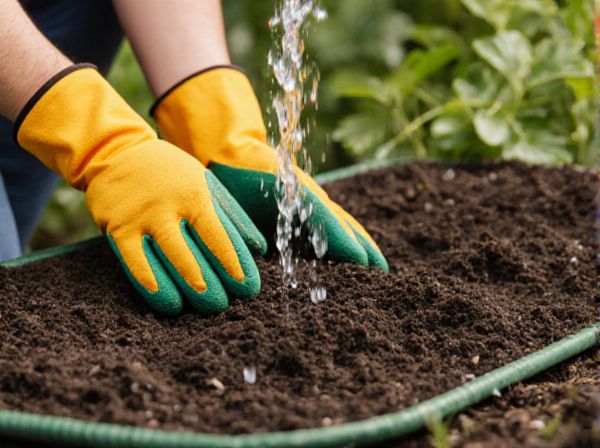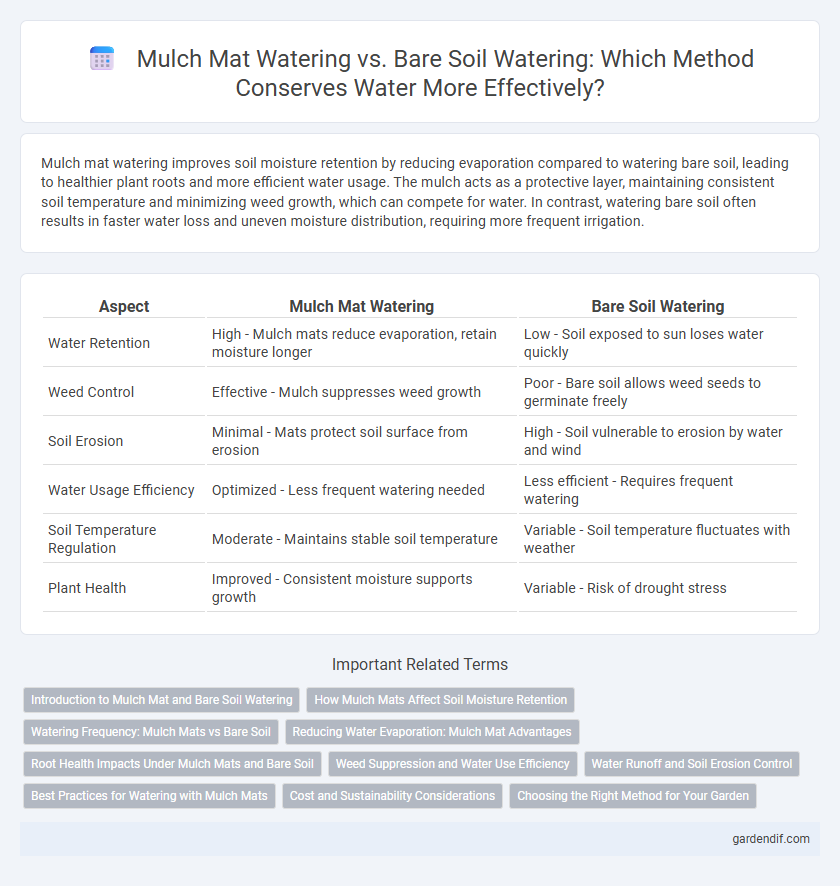
Mulch mat watering vs Bare soil watering Illustration
Mulch mat watering improves soil moisture retention by reducing evaporation compared to watering bare soil, leading to healthier plant roots and more efficient water usage. The mulch acts as a protective layer, maintaining consistent soil temperature and minimizing weed growth, which can compete for water. In contrast, watering bare soil often results in faster water loss and uneven moisture distribution, requiring more frequent irrigation.
Table of Comparison
| Aspect | Mulch Mat Watering | Bare Soil Watering |
|---|---|---|
| Water Retention | High - Mulch mats reduce evaporation, retain moisture longer | Low - Soil exposed to sun loses water quickly |
| Weed Control | Effective - Mulch suppresses weed growth | Poor - Bare soil allows weed seeds to germinate freely |
| Soil Erosion | Minimal - Mats protect soil surface from erosion | High - Soil vulnerable to erosion by water and wind |
| Water Usage Efficiency | Optimized - Less frequent watering needed | Less efficient - Requires frequent watering |
| Soil Temperature Regulation | Moderate - Maintains stable soil temperature | Variable - Soil temperature fluctuates with weather |
| Plant Health | Improved - Consistent moisture supports growth | Variable - Risk of drought stress |
Introduction to Mulch Mat and Bare Soil Watering
Mulch mat watering involves applying water through a layer of organic or synthetic mulch that retains moisture, reduces evaporation, and promotes deeper soil hydration. Bare soil watering directly wets the exposed ground, often leading to faster evaporation, surface runoff, and uneven water distribution. Using mulch mats enhances water efficiency by maintaining consistent soil moisture and protecting plant roots compared to traditional bare soil watering methods.
How Mulch Mats Affect Soil Moisture Retention
Mulch mats significantly enhance soil moisture retention by reducing evaporation rates compared to bare soil watering. Their barrier effect minimizes direct sun exposure and wind impact on the soil surface, maintaining consistent moisture levels essential for plant health. Studies show that mulch mats can retain up to 30% more soil moisture, promoting efficient water use and reducing irrigation frequency.
Watering Frequency: Mulch Mats vs Bare Soil
Mulch mats reduce watering frequency by retaining soil moisture and minimizing evaporation compared to bare soil, which often requires more frequent irrigation due to faster drying. Studies show mulch mats can extend watering intervals by up to 50%, promoting water conservation and healthier root systems. Bare soil typically needs daily or bi-daily watering, whereas mulch mats allow for watering every 3 to 5 days, depending on climate and plant type.
Reducing Water Evaporation: Mulch Mat Advantages
Mulch mats significantly reduce water evaporation by creating a protective barrier over the soil, maintaining consistent moisture levels crucial for plant health. Unlike bare soil, which loses water more rapidly due to direct exposure to sun and wind, mulch mats retain moisture longer, decreasing irrigation frequency. This water-saving advantage enhances drought resistance and promotes efficient irrigation practices in gardening and agriculture.
Root Health Impacts Under Mulch Mats and Bare Soil
Watering under mulch mats maintains consistent soil moisture levels that enhance root aeration and prevent waterlogging, promoting healthier root development compared to bare soil watering. Bare soil watering often leads to rapid surface evaporation and uneven moisture distribution, causing roots to become shallow and stressed. Mulch mats also reduce soil temperature fluctuations, protecting root systems from thermal stress and encouraging deeper, more robust root growth.
Weed Suppression and Water Use Efficiency
Mulch mat watering significantly improves weed suppression by creating a physical barrier that inhibits weed seed germination and growth, reducing competition for water and nutrients. It enhances water use efficiency by retaining soil moisture longer compared to bare soil, minimizing evaporation and promoting deeper water infiltration. Studies indicate that mulch mats can decrease water consumption by up to 30% while maintaining optimal soil hydration for plant health.
Water Runoff and Soil Erosion Control
Mulch mat watering significantly reduces water runoff by enhancing soil permeability and retaining moisture, which prevents the rapid flow of water across the surface. In contrast, bare soil watering often leads to increased runoff and soil erosion due to lack of protective cover and soil structure degradation. Employing mulch mats contributes to effective soil erosion control by stabilizing soil particles and minimizing surface disruption during watering.
Best Practices for Watering with Mulch Mats
Mulch mat watering significantly improves moisture retention compared to bare soil watering by reducing evaporation and promoting deeper water infiltration. Best practices include evenly distributing water over the mulch surface to avoid channeling and ensuring the mulch remains moist but not waterlogged to prevent root rot. Using drip irrigation beneath mulch mats can optimize water efficiency and maintain consistent soil hydration for healthier plant growth.
Cost and Sustainability Considerations
Mulch mat watering reduces water evaporation by up to 50%, leading to lower water usage and cost savings compared to bare soil watering. This method enhances soil moisture retention and decreases irrigation frequency, promoting sustainable water management in landscaping. Over time, mulch mats contribute to improved soil health and reduce the need for chemical fertilizers, further supporting environmental sustainability.
Choosing the Right Method for Your Garden
Mulch mat watering enhances soil moisture retention by reducing evaporation and promoting deeper water absorption compared to bare soil watering. Choosing mulch mats minimizes weed growth and maintains consistent soil temperature, leading to healthier plant roots and better overall garden growth. Bare soil watering requires more frequent irrigation and carries a higher risk of runoff and soil erosion, making mulch mats the more efficient choice for water conservation and plant health.
Mulch mat watering vs Bare soil watering Infographic

 gardendif.com
gardendif.com